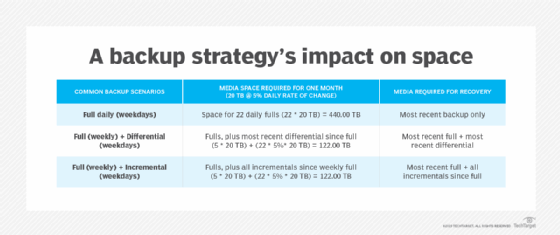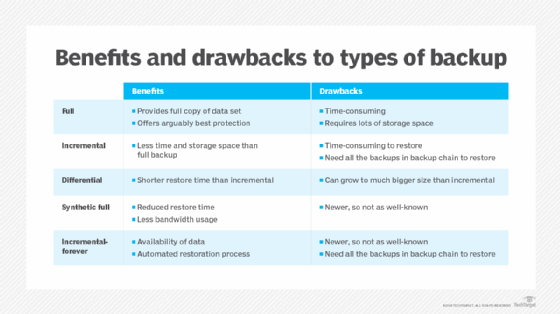Which Type Of Data Backup Is Used To Backup Only Changed Files?
Protecting data confronting loss, corruption, disasters (human-acquired or natural) and other issues is one of the height priorities for It organizations. In concept, the ideas are uncomplicated, although implementing an efficient andeffective set up of fill-in operations can exist difficult.
The term backup has become synonymous with data protection over the past several decades and may be accomplished via several methods. Backup software applications reduce the complexity of performing backup and recovery operations. Backing up data is only i office of a disaster protection plan, and may non provide the level of data and disaster recovery capabilities desired without careful design and testing.
Backup applications have long offered several types of fill-in operations. The near common backup types are a full backup, incremental backup and differential backup. Other fill-in types include synthetic full backups and mirroring.
In the argue over cloud vs. local fill-in, there are some types of backup that are better in certain locations. If you're performing deject backup, incremental backups are generally a better fit considering they swallow fewer resource. You might offset out with a full backup in the cloud and then shift to incremental backups. Mirror fill-in, though, is typically more than of an on-premises approach and frequently involves disks.
1. Full backups
The virtually basic and complete type of backup operation is a full backup. As the proper name implies, this type of backup makes a re-create of all information to a storage device, such every bit a deejay or tape. The primary advantage to performing a full fill-in during every operation is that a complete copy of all data is available with a single set up of media. This results in a minimal time to restore information, a metric known every bit arecovery fourth dimension objective. All the same, the disadvantages are that information technology takes longer to perform a full backup than other types (sometimes by a factor of 10 or more), and it requires more storage infinite.
Thus, full backups are typically run just periodically. Data centers that have a small amount of data (or critical applications) may choose to run a full backup daily, or fifty-fifty more than ofttimes in some cases. Typically, backup operations employ a full fill-in in combination with either incremental or differential backups.
2. Incremental backups
An incremental backup operation will event in copying only the data that has changed since the last fill-in operation of any type. An organization typically uses the modified time postage on files and compares it to the time stamp of the last backup. Fill-in applications runway and tape the date and time that fill-in operations occur in order to rail files modified since these operations.
Because an incremental backup will but copy data since the last backup of any blazon, an organization may run information technology every bit often as desired, with but the most recent changes stored. The benefit of an incremental fill-in is that it copies a smaller amount of data than a full. Thus, these operations will take a faster backup speed, and crave less media to store the fill-in.
iii. Differential backups
A differential backup operation is like to an incremental the get-go fourth dimension information technology is performed, in that it volition copy all data changed from the previous fill-in. Nevertheless, each time it is run afterwards, information technology will continue to copy all data changed since the previous full backup. Thus, information technology will store more backed upward data than an incremental on subsequent operations, although typically far less than a total backup. Moreover, differential backups require more space and time to complete than incremental backups, although less than full backups.

As shown in "A comparing of different types of backup," to a higher place, each backup process works differently. An organisation must run a full backup at to the lowest degree in one case. For subsequent backups, it is possible to run either another full, an incremental or a differential fill-in. The first partial backup performed, either a differential or incremental, will support the same information. By the third backup operation, the information that is backed upwardly with an incremental is limited to the changes since the last incremental. In comparing, the third backup with a differential will support all changes since the showtime total backup, which was "Fill-in i."
From these three chief types of backup, it is possible to develop an approach for comprehensive data protection. An organization often uses i of the following backup settings:
- Full daily
- Full weekly + differential daily
- Full weekly + incremental daily
Many considerations will affect the choice of the optimal backup strategy. Typically, each alternative and strategy pick involves making tradeoffs between performance, data protection levels, full amount of data retained and toll. In "A fill-in strategy's impact on space" below, the media capacity requirements and media required for recovery are shown for three typical backup strategies. These calculations assume 20 TB of total data, with 5% of the data changing daily, and no increase in total storage during the menstruum. The calculations are based on 22 working days in a month and a one-month retentiveness period for data.

As shown in a higher place, performing a full fill-in daily requires the most amount of space, and will also take the most amount of time. However, more total copies of data are available, and fewer pieces of media are required to perform a restore operation. Equally a result, implementing this backup policy has a higher tolerance to disasters, and provides the least fourth dimension to restore, since any piece of data required volition exist located on at most one fill-in set up.
As an culling, performing a total backup weekly, coupled with running incremental backups daily, will deliver the shortest backup time during weekdays and use the least corporeality of storage space. Notwithstanding, at that place are fewer copies of data available and restore time is the longest, since an organization may need to use half-dozen sets of media to recover the necessary information. If data is needed from data backed upwards on Wed, the Sunday full fill-in, plus the Monday, Tuesday and Wed incremental media sets, are required. This can dramatically increase recovery times, and requires that each media gear up work properly; a failure in ane backup fix can impact the entire restoration.
Running a weekly total backup plus daily differential backups delivers results in between the other alternatives. Namely, more than backup media sets are required to restore than with a daily full policy, although less than with a daily incremental policy. Also, the restore time is less than using daily incremental backups, and more than than daily full backups. In gild to restore data from a particular day, at virtually two media sets are required, diminishing the time needed to recover and the potential for problems with an unreadable backup set up.
4. Mirror backups
A mirror backup is comparable to a full backup. Co-ordinate to a blog from backup vendor Nakivo, "This backup type creates an exact copy of the source data set, but but the latest data version is stored in the backup repository with no track of unlike versions of the files." The backup is a mirror of the source data, thus the proper noun. All the unlike backed up files are stored separately, like they are in the source.
One of the benefits of mirror backup is a fast data recovery time. It's besides easy to access individual backed up files.
One of the main drawbacks, though, is the amount of storage infinite required. With that extra storage, organizations should be wary of toll increases and maintenance needs. In add-on, if at that place'southward a problem in the source data set, such as a corruption or deletion, the mirror fill-in experiences the same. As a result, it's a practiced thought non to rely on mirror backups for all your data protection needs, and to have other types of backup for the data. Yous'll desire to follow the three-2-ane dominion of fill-in, which includes three copies of data on two unlike media, with one copy off site.
One specific kind of mirror, disk mirroring, is also known as RAID 1. This procedure replicates data to two or more than disks. Disk mirroring is a potent option for data that needs loftier availability considering of its quick recovery time. It's besides helpful for disaster recovery because of its firsthand failover capability. Disk mirroring requires at least two concrete drives. If one hard bulldoze fails, an system can employ the mirror copy. While deejay mirroring offers comprehensive data protection, it requires a lot of storage chapters.
Do the right thing for your organization
For organizations with small data sets, running a daily full backup provides a high level of protection without much additional storage space costs. Larger organizations or those with more than data or server volume find that running a weekly full backup, coupled with either daily incremental backups or differential backups, provides a better option. Using differentials provides a college level of data protection with less restore time for most scenarios and a small increase in storage chapters. For this reason, using a strategy of weekly total backups with daily differential backups is a good option for many organizations.

Most of the avant-garde types of fill-in such as synthetic full, mirror and continuous data protection require deejay storage as the fill-in target. A constructed full just reconstructs the full backup image using all required incremental backups or the differential backup on disk. This synthetic full may then exist stored to tape for offsite storage, with the advantage existence reduced restoration time. Finally, continuous information protection enables a greater number of restoration points than traditional backup options.
When deciding which blazon of backup strategy to use, the question is when to use each, and how these options should be combined with testing to see the overall business toll, performance and availability goals.
The purpose of most backups is to create a copy of data so that a particular file or application may be restored afterwards data loss, corruption or deletion, or a disaster strikes. Thus, fill-in is not the goal, but rather information technology is one means to accomplish the goal of protecting data. Testing backups is simply as of import as data fill-in and restore. Again, the betoken of data backup is to enable restoration of data at a afterwards point in time. Without periodic testing, it is incommunicable to guarantee that the goal of protecting data is being met.
Dig Deeper on Deejay-based backup
-

Full vs. incremental vs. differential: Comparing backup types
-

Full Fill-in
-

Differential Backup
-

Incremental Fill-in
Source: https://www.techtarget.com/searchdatabackup/feature/Full-incremental-or-differential-How-to-choose-the-correct-backup-type
Posted by: gasparhossing.blogspot.com





0 Response to "Which Type Of Data Backup Is Used To Backup Only Changed Files?"
Post a Comment